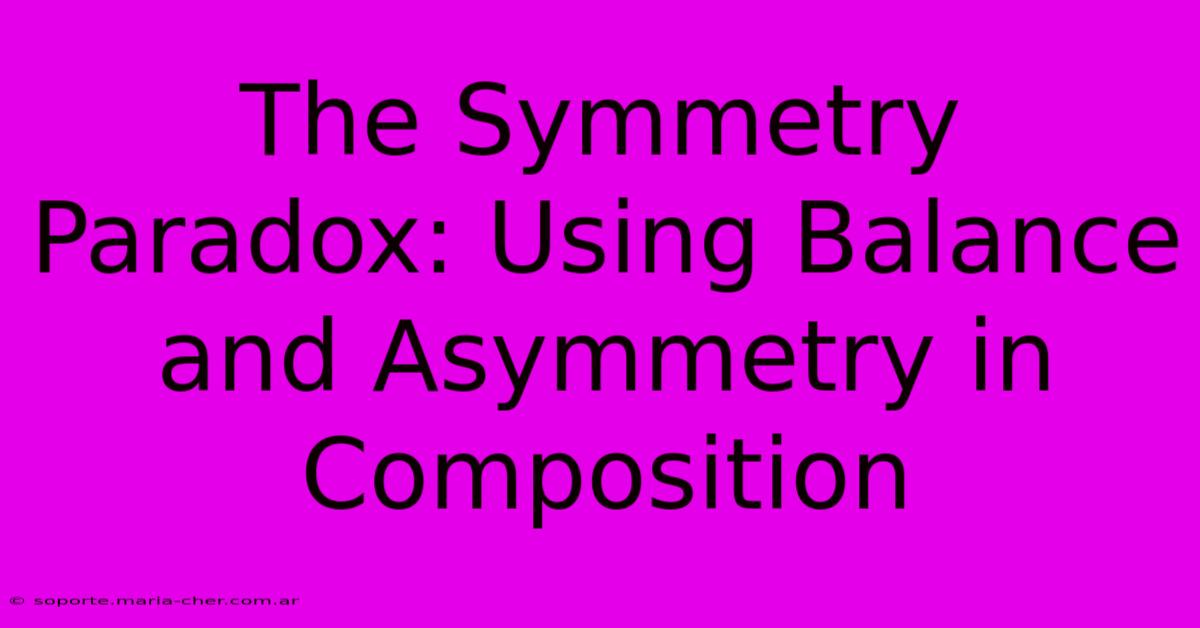The Symmetry Paradox: Using Balance And Asymmetry In Composition

Table of Contents
The Symmetry Paradox: Using Balance and Asymmetry in Composition
Visual art, design, and even photography hinge on a fundamental principle: composition. Understanding how to arrange elements within a frame is crucial for creating impactful and engaging work. While symmetry often evokes feelings of harmony and stability, the true power lies in mastering the symmetry paradox: the skillful interplay of balance and asymmetry. This article will explore how to leverage both to create compelling compositions that captivate your audience.
The Allure of Symmetry
Symmetrical compositions, characterized by a mirroring effect around a central axis, are inherently pleasing to the eye. They offer a sense of order, predictability, and tranquility. Think of classic Renaissance paintings, architectural marvels like the Taj Mahal, or the perfectly balanced logo designs of many major corporations.
Why Symmetry Works:
- Visual Stability: Our brains naturally gravitate towards balanced arrangements. Symmetry provides this inherent stability, creating a sense of calm and reassurance.
- Ease of Understanding: Symmetrical compositions are easy to process visually. The mirrored elements create a clear focal point and a predictable structure.
- Formal Feel: Symmetry often communicates formality, sophistication, and even authority.
Examples of Effective Symmetry:
- Reflective symmetry: A photograph reflecting across a still body of water.
- Radial symmetry: A mandala design with patterns radiating from a central point.
- Bilateral symmetry: A portrait photograph with the subject perfectly centered.
Breaking the Rules: The Power of Asymmetry
While symmetry offers a safe and often effective approach, true creative expression frequently involves embracing asymmetry. Asymmetry, characterized by an uneven distribution of elements, can introduce dynamism, tension, and unexpected visual interest. It challenges the viewer, inviting a deeper engagement with the artwork.
Why Asymmetry Works:
- Visual Interest: Asymmetrical compositions are less predictable, creating a more engaging and captivating experience for the viewer. The eye is constantly drawn to different elements, preventing visual fatigue.
- Dynamic Energy: Asymmetry often conveys movement, energy, and emotion. It can suggest action, excitement, or even chaos, depending on the arrangement.
- Modern Feel: Asymmetrical compositions often feel more contemporary and less formal than symmetrical ones.
Examples of Effective Asymmetry:
- Rule of Thirds: Placing key elements off-center, following the rule of thirds, creates a more visually pleasing asymmetry.
- Leading Lines: Using lines to guide the viewer's eye through the composition, creating an uneven distribution of elements.
- Visual Weight: Balancing different elements with varying sizes, colors, and textures to create a sense of equilibrium despite the lack of symmetry.
The Symmetry Paradox in Practice: Achieving Balance Through Imbalance
The key to mastering composition lies in understanding how to create visual balance even when using asymmetrical elements. Visual weight is the perceived importance or dominance of an element in a composition. A large, dark object will have more visual weight than a small, light one.
Techniques for Achieving Balance in Asymmetrical Compositions:
- Visual Weight Distribution: Distribute visual weight strategically. A smaller, brightly colored element might balance a larger, darker one.
- Color Contrast: Use contrasting colors to create visual equilibrium. A small, vibrant spot of color can balance a large area of muted tones.
- Placement: Strategic placement of elements can also create a sense of balance. A single, large element placed off-center might be balanced by several smaller elements clustered on the opposite side.
- Negative Space: Don't underestimate the power of negative space. Strategic use of empty space can create visual balance and draw attention to specific elements.
Conclusion: Embracing the Tension
The symmetry paradox highlights the fascinating tension between order and chaos, stability and dynamism. Mastering both symmetrical and asymmetrical compositions allows you to express a wide range of emotions and ideas in your work. Experiment with different techniques, analyze successful compositions, and develop your own intuitive understanding of visual balance to create truly impactful and memorable pieces. By understanding and effectively utilizing this paradox, you can elevate your creative work to a new level of sophistication and engagement.

Thank you for visiting our website wich cover about The Symmetry Paradox: Using Balance And Asymmetry In Composition. We hope the information provided has been useful to you. Feel free to contact us if you have any questions or need further assistance. See you next time and dont miss to bookmark.
Featured Posts
-
Unlock The Secrets Of Google Discovery Dominance With Html Signature Emails
Feb 09, 2025
-
Red Line On The Flag A Symbol Of Division Or Unity
Feb 09, 2025
-
Mays Blossoming Hues Awaken Your Creativity With The Colors Of New Beginnings
Feb 09, 2025
-
Astonishing Truth How Hdmi Cord Lengths Affect Your Home Cinema Experience
Feb 09, 2025
-
The Red Lines Secret A Symbol Of Courage And Dissent
Feb 09, 2025
